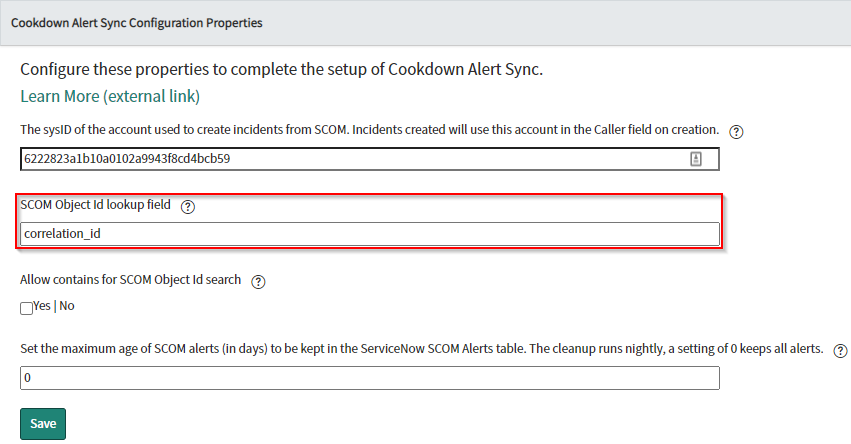Automatically Mapping Configuration Items
If you have both our Alert Sync and Discovery products we can automatically map Incidents/Tasks we raise from SCOM alerts to the correct Configuration Items. This process works by populating a field on each CI with its SCOM object ID using our discovery tool, which exposes the SCOM Object IDs themselves, and then checking each incoming SCOM alert against the SCOM Object Ids of discovered CIs.
Setting up automatic CI mapping
To set up this capability, firstly decide which field in your CMDB to store the SCOM object ID in, populate the field with Cookdown Discovery and configure Alert Sync to check this field for SCOM Object ID. For the below worked example we have used the "correlation_id" field for this purpose.
Using the correlation_id field is acceptable in ServiceNow instances apart from where ServiceNow's SCCM connector is in use (as it uses these fields for its own IDs) or any other discovery tool that populates this field
1. Agree the field to be used for automatic CI mapping - in this example we use correlation_id
2. Populate the agreed field using Cookdown Discovery. The following sample Discovery payload is for populating Active Directory Controllers. Read more on Cookdown Discovery payloads:
{
"items": [
{
"className": "cmdb_ci_ad_controller",
"lookup": [],
"values": {
"dns_domain": "Microsoft.Windows.Computer:::DomainDnsName",
"forest_name": "Microsoft.Windows.Computer:::ForestDnsName",
"name": "Microsoft.Windows.Server.10.0.AD.DomainControllerRole::Microsoft.Windows.Server.AD.Library.DomainControllerRole::Name",
"fqdn": "Microsoft.Windows.Computer:::PrincipalName",
"ip_address": "Microsoft.Windows.Computer:::IPAddress",
"domain_controller_name": "Microsoft.Windows.Computer:::PrincipalName",
"domain_name": "Microsoft.Windows.Computer:::DomainDnsName",
"sys_class_name": "cmdb_ci_ad_controller",
"correlation_id": "Microsoft.Windows.Server.10.0.AD.DomainControllerRole:ObjectId"
}
}
],
"relations": [ ]
}
3. Configure Alert Sync to look at the populated field through the “Cookdown Configuration“ menu
4. If the field you have chosen to populate contains data other than a single SCOM Object Id check the "Allow contains for SCOM Object Id Search" box
Use of the contains search is more load intensive on your ServiceNow instance so while we provide this functionality, we recommend you store the SCOM Id in a field by itself
5. In each Creation Rule that you wish to use automatic CI mapping with, check the Automatically map CI checkbox and provide a fallback CI. The Fallback CI is used where automatic CI mapping can find no CI in your CMDB with a SCOM object corresponding to the SCOM alert that the Creation Rule is evaluating
Use of automatic CI mapping is not mandatory and can be enabled for a subset of your Creation Rules if required

